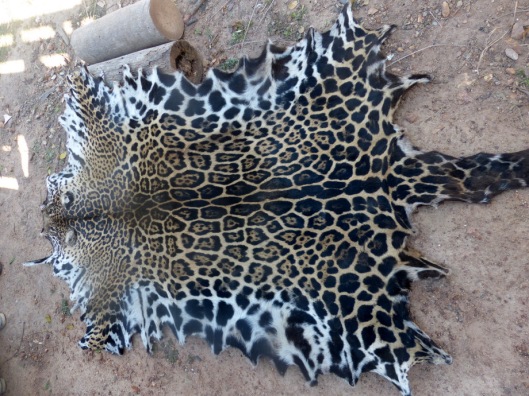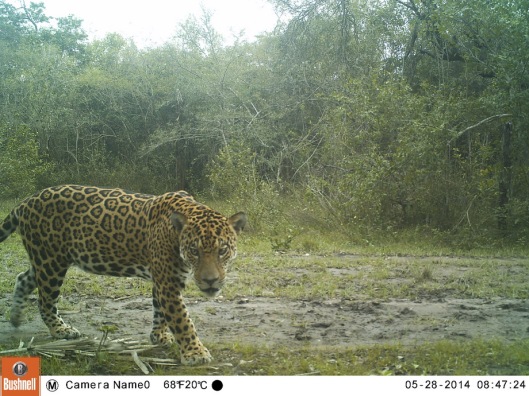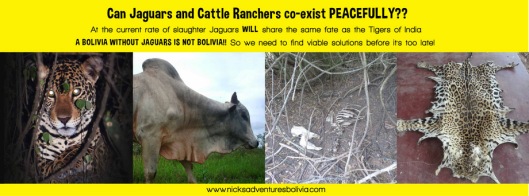Centrum Hodowli Bydła San Miguelito znajduje się zaledwie 180 km od Santa Cruz de la Sierra (lub 3 godziny jazdy samochodem) i jest domem dla…jaguarów. Dlaczego? – ziemia w tej tropikalnej części Boliwii, która nie tak dawno pokryta była lasem, została niemal całkowicie wykarczowana pod uprawę soi. Ranczo San Migelito, jako jedyne w tym regionie posiadające pozostałości pierwotnego lasu, przyciąga wszelkiego rodzaju dzikie zwierzęta, które szukają tu schronienia.
Gospodarstwo posiada w swoim obrębie suchy las Chiquitano, podmokle Pampas oraz wilgotny górski las, będące domem dla niezwykle zróżnicowanej fauny. Oprócz jaguarów, tereny te zamieszkuje 5 różnych gatunków dużych kotów tj.: puma, ocelot, kot Geoffreya, jaguarundi i margay. Występują tam również inne unikalne dzikie zwierzęta, mi.in. nizinne tapiry, mrówkojady olbrzymie, pancerniki, kajmany, pekari, jelenie i wiele innych. Zróżnicowany ekosystem jest i siedliskiem dla ponad 150 gatunków ptaków.
The Cattle Farm of San Miguelito is located just 180 km from Santa Cruz de la Sierra (or 3 hours’ drive) and hosts the highest densities of…Jaguars found anywhere on the planet. How come? – the land in this tropical part of Bolivia which used to be covered by a dense forest was almost completely cleared for soya fields and the ranch of San Miguelito, as the only property in this region having some of the natural forest remaining, attracts all kinds of wild animals seeking refuge.
These properties consist of Chiquitano dry forest, Pampas wetlands and humid mountainous forest and host a wide array of wildlife. Apart of Jaguars there are other five species of big cats to be seen: Puma, Ocelot, Geoffrey’s cat, Jaguarundi and Margay. Other threatened and unique wild animals include: Lowland Tapirs, Giant Anteaters, Giant Armadillos, Caimans Anacondas, Monkeys, White lipped Peccaries, Brocket Deers and much more. This diverse habitat is a birders heaven too, with over 150 species of birds being recorded.
Niestety, ten mały raj okazuje się być także śmiertelna pułapka, zwłaszcza dla wielkich kotów. Chociaż gospodarstwo San Miguelito nie zezwala na polowania, jaguary i pumy giną z rak ranczerów, ponieważ są one postrzegane jako zagrożenie dla bydła.
Unfortunately, this little paradise turns out to be also a deadly trap especially for Big Cats. Although this farm has a ‘no hunting policy’, many Jaguars and Pumas are killed because they are seen as a threat to the cattle.
Problem jest jednak bardziej złożony i nie ogranicza się tylko do Boliwii, ale całej Ameryki Łacińskiej. Od czasu do czasu słyszę o zabiciu jaguara w okolicach Santa Cruz – w ostatnim miesiącu w pobliskim Warnes. Ludzie mówili, ze zabili zwierzę w samoobronie, ale czy musieli oni publikować swoje uśmiechnięte ‘selfies’ z jego ciałem na Facebooku? Prawdę mówiąc, bardziej mi to przypomniało polowanie dla przyjemności niż z konieczności. Ludzie nie zdaja sobie sprawy, iż jaguary są klasyfikowane jako bliskie zagrożenia wyginięciem. W samej Boliwii nadal można znaleźć je w względnie dużej liczbie, ale sytuacja szybko ulega zmianie. W sąsiedzkiej Argentynie, populacja jaguara spadla do zaledwie 200 osobników i istnieje zagrożenie, ze następne pokolenia będą mogły zobaczyć to zwierzę tylko w zoo. Jaguary w ostatnim stuleciu straciły 40 procent swojego zakresu geograficznego i są obecnie uznane za gatunek wymarły w Urugwaju oraz Salwadorze. Do tej listy mogą wkrótce dołączyć Stany Zjednoczone, Kostaryka, Panama i Nikaragua.
This is not only a problem of San Miguelito – but Latin America wide. From time to time I can hear of a Jaguar being killed in the area of Santa Cruz de la Sierra – last month in nearby Warnes. People say they killed it to protect themselves but did they really have to post pictures of their smiley selfies over the body of a dead animal on Facebook? That reminds more of trophy hunting than a self-defense killing. People are not aware that Jaguars are classified as near threatened animals. In Bolivia Jaguars can still be found in relative healthy numbers however this is rapidly changing. In Argentina the Jaguar has gone from being common species to a population of less than 200 and one that is severely unlikely to survive the next generations. Jaguars have lost 40 percent of their geographical range and are now extinct in Uruguay, El Salvador and likely to join the extinction list in United States, Costa Rica, Panama and Nicaragura.
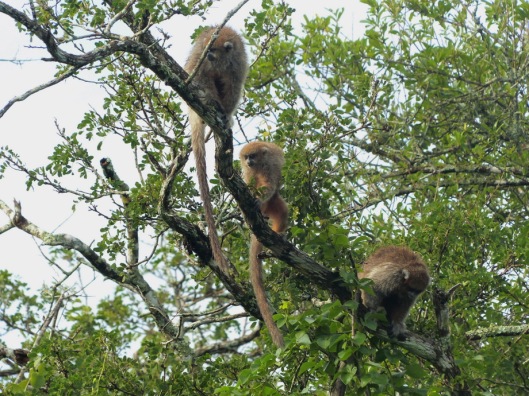
Czy istnieje wiec ratunek dla tych majestatycznych kotów? Czy jaguary i ranczerzy moga spokojnie koegzystowac? Jednym ze sposobów ochrony przyrody na obszarach zaludnionych jest zrównoważona i kontrolowana EKO – TURYSTYKA, która została wprowadzona do San Miguelito przez Nicolasa Mcphee – współwłaściciela i przewodnika biura podroży ‘Nick’s Adventures Bolivia’. Firma Nicka, z siedziba w Santa Cruz de la Sierra, organizuje wycieczki do San Miguelito, tym samym przyczyniając się do zmniejszenia strat spowodowanych przez jaguary/złodziei bydła.
So, how can we rescue the big cats? Can jaguars and cattle farmers co-egsist peacefully? One of the ways of protecting wildlife in populated areas is sustainable and controlled eco-tourism brought to San Miguelito Cattle Station by Nicholas Mcphee – co-owner and tour operator of Nick’s Adventures Bolivia. His travel agency located in Santa Cruz de la Sierra organizes tours to this facility, helping to alleviate the damage caused by jaguar/livestock depredation.

Jak działa eko-turystyka? Nick oddaje duża cześć własnych dochodów z każdej wycieczki na pokrycie szkód spowodowanych przez wielkie koty oraz wspierając jedynego hodowcę w regionie, który zostawił naturalny las na swoim terenie, w zwiększeniu liczebności zwierząt łownych.
A liczby mówią same za siebie: na sześciu okolicznych ranczach straty wynoszą od 60-100 sztuk rocznie, choć jak uważa Nick, większość z nich nie pada ofiarami drapieżników, a złodziei bydła. Gospodarstwo San Miguelito straciło w tym roku 3 krowy. W tym samym czasie zabito tam 1 samice jaguara w ciąży, 1 pume i 1 ocelota. Szacuje się również, iż inne 3 duże koty zostały postrzelone i ranne. Na sasiednich farmach w tym roku zabito co najmniej 2 jaguary. Zazwyczaj rocznie ginie w okolicy San Miguelito od 2-5 jaguarów.
How does eco- tourism work? Nick donates large percentage of his own profit from every tour to the cattle ranch to cover the damages caused by big cats and to support the only farmer in the region who has left the natural forest in increasing the prey abundance.
And numbers speak for themselves: across 6 ranches in the area they lose around 60-100 cattle per year to Jaguar/Puma predation, although Nick believes, a lot of these are not from cats but rather theft. On San Miguelito Ranch they have lost 3 cows this year so far. This year across the ranches, they have killed 1 pregnant jaguar, 1 puma and 1 ocelot. It’s also estimated that 3 big cats were shot and wounded. On the neighboring ranches they have killed at least 2 jaguars this year. Generally around 2-5 jaguars are killed per year. Nick adds that ‘situation in Beni (Northern Bolivia) is far worse, with up to 10 jaguars killed every year per Ranch.

Jedna sztuka zabitego bydła kosztuje około 250 $ – więcej pokrytych strat to mniej zabitych jaguarów i pum (przynajmniej na ranchu San Miguelito). Turyści, którzy decydują się na dana wycieczkę, mogą podziwiać faunę i florę południowoamerykańska w całej swojej krasie, jednocześnie wspierając słuszna sprawę. Nick dodaje, ze sytuacja w Beni (na północy Boliwii) jest o wiele powazniejsza, bowiem zabijanych jest tam okolo 10 jaguarow rocznie.
‘Na poczatek Boliwia musi utworzyc obowiazkowy rejestr zabitych jaguarów uwzgledniający ich pleć, wagę, stan zębów, wielkość, wszelkie informacje o zmianach fizycznych, deformacjach oraz powod zabicia zwierzecia. Dopiero, gdy rząd oraz stowazyszenia ochrony zwierzat beda mialy pelne pojecie o skali smiertelnosci jaguarów, zaczną one realizowac plan ochrony tych zwierzat przed lokalnym i calkowitym wyginieciem.’
One killed cattle costs its owner about 250$ so every penny counts. More loses covered, less jaguars and pumas killed (at least in San Miguelito Ranch). The math is simple. The tourists who decide to go on that particular tour get to see wild South American fauna and flora, in the same time supporting the great cause.
‘In the very least Bolivia needs a mandatory register of jaguars killed, i.e.: male/ female, weight, condition of teeth, size, physical abnormalities, pregnancy and reason it was shot. If this is done in the very least conservation and government agencies will have an idea of Jaguar mortalities and begin to implement plans to save them from local and permanent extinction’, says Nick.
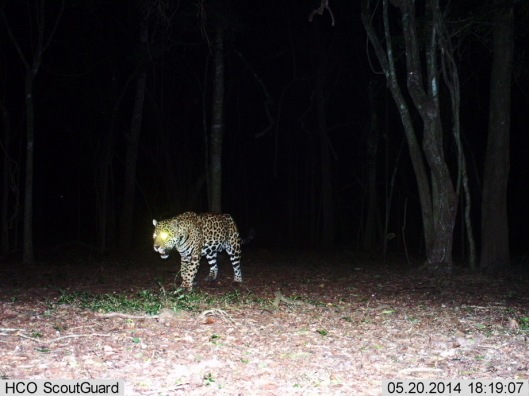
Hodowla zwierzat ubojowych kompatybilna z ochrona srodowiska naturalnego wokol pierwszych prywatnych rezerw Boliwii w San Miguelito od lat wspierana jest przez Wildlife Conserwation Society (WCS). W 2002 roku, WCS rozpoczela systematyczne badania za pomoca ukrytych kamer w Parku Narodowym Kaa – Iya – najwiekszym chronionym suchym tropikalnym lesie na swiecie oraz w San Miguelito. Wyniki badan byly oszalamiajace. Oszacowano, ze w samym parku zyje 1000 jaguarow, stanowiac tym samym najwieksza chroniona populacje jaguarow na swiecie. Ponadto, tylko na terenie San Miguelito, otoczonym krajobrazem rolniczym, znajduje sie 6 jaguarow i 7 pum! Jak juz wspomnialam wczesniej, obszar ten jest rowniez pierwszym w Ameryce Lacinskiej, gdzie potwierdzono obecnosc 6 roznych gatunkow dzikich kotow!
Wildlife compatible ranching around Bolivia’s first private reserves at San Miguelito for years has been supported by Wildlife Conservation Society (WCS). In 2002 WCS initiated systematic camera trap surveys in Kaa -Iya National Park, the largest protected tropical dry forest in the world and San Miguelito Private Reserve. The results were outstanding. Park’s estimated 1000 jaguars represent the single largest protected jaguar population anywhere. In addition, the small protected area of San Miguelito, located between the agricultural landscapes, consists of 6 jaguars and 7 pumas! As I mentioned before, this site is also the first in Latin America to confirm the presence of 6 wild cat species!
Nick takze ustawia ukryte kamery w roznych strategicznych czesciach rancza, w ten sposob uzyskujac informacje na temat sciezek poszczegolnych jaguarow, gestosci ich wystepowania oraz obfitosci zwierzyny lownej. Podczas wycieczki turysci pomagaja mu w sprawdzaniu kamer, w montowniu nowych urzadzen, jak rowniez wykonuja oni odlewy gipsowe sladow wielkich kotow oraz szukaja padliny, by sprawdzic, jaka zwierzyna padla lupem drapieznikow.
Nick has also set up camera traps around strategic parts of ranches to obtain information about jaguar routes, densities and prey abundance. While on tour, tourists help him out by checking the camera traps and setting up new ones as well as making plaster molds of jaguar tracks and looking for scat to check what prey was eaten up by big cats.
Pewnie zastanawiasz sie, czy nalezy sie bac spotkania z jaguarem? Moge Cie pocieszyc – jaguary prawdopodobnie bardziej obawialyby sie spotkania z Toba! W przeciwienstwie do ludzi, wielkie koty zabijaja z koniecznosci, nie dla zabawy. Zreszta, wokol maja sporo smaczniejszych kaskow do wyboru;)
Should you be scared of jaguar encounter? Don’t worry, the jaguar would probably be more scared of you! Unlike people, the big cats kill to eat, not for fun. And at San Miguelito they have much more tasty alternatives to choose from;)
Wiecej na temat projektu Nick’s Adventures Bolivia/ To learn more about Nick’s Adventures Bolivia Jaguar Conservation Tour, visit: : www.nicksadventuresblivia.com i http://www.nicksadventuresbolivia.com/san-miguelito-jaoguar-conservation-tour/ (podane strony dostepne sa jedynie w jezyku angielskim).
Aby dowiedziec sie wiecej na temat ochrony jaguarow w Boliwii odwiedz/ To find out more about jaguar conserwation in Bolivia, visit:: www.wcs.org, www.news.mongabay.com.
Pdf: http://www.wildexplorations.com/jaguar & http://geog.ufl.edu (ukryte kamery – pułapki w ochronie zwierząt).
Wszystkie zdjęcia dzięki uprzejmości Nickolasa Mcphee/ All photographs cortuesy of Nickolas McPhee.

